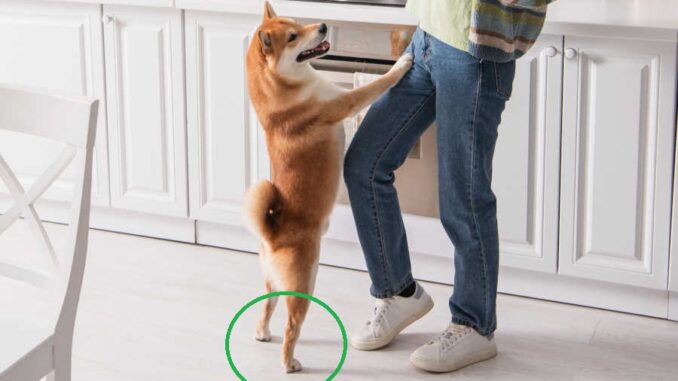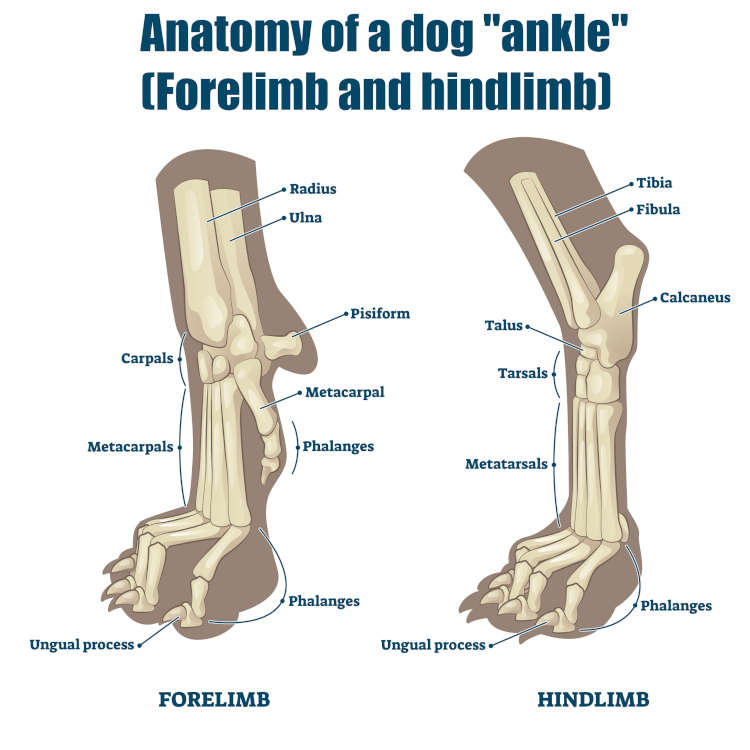
A dog’s ankle is an intricate device made up of bones, muscles, and connective tissue that allow them to run, jump, and all of the other amazing things they do every day. When you’re dealing with something with so many moving parts, it’s no wonder that sometimes these parts can run into some issues. And one of the main ways that these issues present themselves is with swelling. As a veterinarian, swollen legs, including ankles, is a common and even daily case that we have to figure out. We’re here to help you get to the bottom of what’s causing of your dog’s swollen ankle and what you can do about it.
Where are a Dog’s Ankles?
Dogs have all of the same bones in their legs that we humans do, they’re just in a slightly different orientation. They have toe and metatarsal bones that make up the foot that meet with the bones of the shin at the tarsal joint, also known as the ankle in humans. In dogs, this tarsal joint isn’t at the bottom of the leg, it’s actually found about midway up. This is because dogs actually walk on their toes instead of laying down their entire foot as we do.

The ankle joint, also called the hock, makes a V with the point toward the dog’s tail. When it flexes, it drops the dog’s foot toward the ground. When it extends, it lengthens a dog’s leg to make them stand up tall or jump.
A dog’s ankle joints are very important for walking around, standing up, jumping, and even scratching their ears. They are in use nearly all of the time. When a joint is used a lot, it opens it up to all kinds of injuries, infections, and other issues that could cause swelling. Let’s find out more.
Signs of Swollen Ankles in Dogs
A swollen ankle is just that, swelling in or around the ankle joint. It can be very mild or very severe depending on the cause. Since swelling is part of the inflammatory process, you may also notice:
- Heat
- Redness
- Pain
- Loss or reduced function
Your pup may not be very happy when they have a swollen ankle. They probably won’t be as active or will limp or carry the leg. Sometimes they may even have a decreased appetite and whine or cry when they try to use the leg or when you touch it.
Causes of Swollen Ankles in Dogs
There is a number of reasons why your pup’s ankle may be swollen, some more severe than others. Here are some possible causes of swollen dog ankles and what needs to be done about them.
Injury
Sprain, fractures, dislocations, and connective tissue tears are all capable of causing a swollen dog ankle. These injuries can come about by repetitive use, abnormal twisting or turning, or from a trauma such as a car accident. Either way, swelling usually accompanies the injury along with pain, limping, or not wanting to use the leg. If the injury was from a trauma, your pup may have other swellings or lacerations to check for as well.
Injuries to a pup’s ankle will need to be treated accordingly. Sprains will require rest, anti-inflammatories, and icing. Fractures and tears may need splinting, casting, or surgery. Dislocations will need to be replaced using sedation and manipulation or surgery along with possibly splinting or casting to help the healing process.
Infection
Wounds or bites around the ankle joint can lead to an infection and swelling. Along with some extra puffiness, you may notice a lot of heat around the joint as well as possibly some discharge. If infections are severe enough they could make your pup pretty sick and not want to eat or move much.
Infections are often cleared with a course of antibiotics, but it’s not always that easy. Infections in the joint itself can be difficult to clean out with oral antibiotics alone and may require flushing or injections to get things back to normal.
Arthritis
Arthritis in a simple sense is inflammation of a joint. It’s a very common thing, especially in older and active dogs. Over time this inflammation can actually lead to boney changes in the joint which further makes more inflammation. What you may be left with is a swollen and painful ankle joint that your dog doesn’t want to use as much. Dogs will arthritis often have a decreased range of motion and will typically be worse first thing in the morning.
Mild to moderate arthritis is often managed with anti-inflammatories and icing. Joint supplements that contain glucosamine, chondroitin, and omega fatty acids can help repair the joint to some extent. Severe arthritis may require surgery or even fusing the joint so that a dog can move around comfortably again.
Others
Some less common causes of swollen dog ankles are insect bites or stings that cause lots of swelling in the skin over the ankle or an autoimmune disease that affects multiple joints. Be sure to see your vet if your dog’s ankle swelling doesn’t get better or if you are at all concerned.
How to Tell if My Dog’s Ankle is Broken or Just Sprained
Sprains and fractures are some of the most common causes of swollen dog ankles. They are also very similar in how they present. Both will show swelling and pain. Your dog may or may not use their leg with either. Sprains and fractures may each come with other injuries, redness, or heat over the joint as well.
The only true way to determine if your dog’s ankle is broken or sprained is with an x-ray. This will show any boney changes along with possibly pinpointing the area of inflammation to target a specific area of the ankle joint. Fractures and sprains will need to be treated differently, so it’s important to know which one you’re dealing with.
At Home Treatments for Swollen Dog Ankles
Since there are a lot of moving parts in a dog’s ankle and many things that can go wrong with it, it’s always best to get a veterinary diagnosis of any swelling of the joint. However, that can’t always happen right away, so here are some steps you can take at home as you prepare for your appointment.
- Rest and relaxation: Don’t continue to aggravate the swelling by letting your dog continue to run and play (if they even want to!). Instead, set them up in a comfortable and confined spot to give that joint a break.
- Anti-inflammatories: After contacting your vet, you may give your pup some anti-inflammatories to help with any pain and to start to bring down the swelling. Always consult your vet first to give the proper medication and dose.
- Icing: Most swelling really responds to icing and it can help dull the pain. You may try to apply a cold compress or ice pack to your dog’s swollen ankle for 10-15 minutes every 4-6 hours. Just make sure you’re not applying the ice directly to the skin.
When to Seek Veterinary Care for Swollen Dog Ankles
If your dog shows up with a swollen ankle, your best bet is to get a veterinary diagnosis. This is especially true if you know of any trauma that your dog experienced or if they are showing signs of extreme discomfort like not eating, not wanting to get up, or not wanting to use the leg.
If your pup only has mild swelling of their ankle and they aren’t terribly uncomfortable, you may choose to try icing and resting them for a day to two to see if the swelling gets better. If things aren’t looking up or if they get worse, schedule a vet appointment right away.
If My Dog in Pain From a Swollen Ankle?
As you’ll remember from earlier, swelling is part of the inflammatory process. So is pain. That doesn’t mean that swelling always causes pain, but the two usually go hand in hand. You’ll know your dog is painful from their swollen ankle if they limp or choose not to use the affected leg. They may also whine or cry when they try to use the leg or when you touch it. Muscle trembling or licking the ankle joint may happen as well. Since you don’t want to see your canine companion in pain, be sure to check in with your veterinarian.
Disclaimer: This website's content is not a substitute for veterinary care. Always consult with your veterinarian for healthcare decisions. Read More.


Be the first to comment